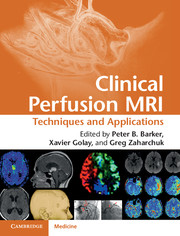Book contents
- Frontmatter
- Contents
- List of Contributors
- Foreword
- Preface
- List of Abbreviations
- Section 1 Techniques
- Section 2 Clinical applications
- 8 MR perfusion imaging in neurovascular disease
- 9 MR perfusion imaging in neurodegenerative disease
- 10 MR perfusion imaging in clinical neuroradiology
- 11 MR perfusion imaging in oncology: neuro applications
- 12 MR perfusion imaging in oncology: applications outside the brain
- 13 MR perfusion imaging in breast cancer
- 14 MR perfusion imaging in the body: kidney, liver, and lung
- 15 MR perfusion imaging in cardiac diseases
- 16 MR perfusion imaging in pediatrics
- Index
- References
10 - MR perfusion imaging in clinical neuroradiology
from Section 2 - Clinical applications
Published online by Cambridge University Press: 05 May 2013
- Frontmatter
- Contents
- List of Contributors
- Foreword
- Preface
- List of Abbreviations
- Section 1 Techniques
- Section 2 Clinical applications
- 8 MR perfusion imaging in neurovascular disease
- 9 MR perfusion imaging in neurodegenerative disease
- 10 MR perfusion imaging in clinical neuroradiology
- 11 MR perfusion imaging in oncology: neuro applications
- 12 MR perfusion imaging in oncology: applications outside the brain
- 13 MR perfusion imaging in breast cancer
- 14 MR perfusion imaging in the body: kidney, liver, and lung
- 15 MR perfusion imaging in cardiac diseases
- 16 MR perfusion imaging in pediatrics
- Index
- References
Summary
Introduction
While the earliest uses of MR perfusion imaging were primarily in oncological and neurovascular imaging, increasingly MR perfusion has shown its utility both in research and clinical practice in a large range of both normal physiological states and pathological conditions. MR perfusion improves disease characterization, and with the growing number of entities studied, it becomes useful and at times necessary to categorize perfusion patterns. Changes in brain perfusion parameters can loosely be grouped into either global or focal, and either hypo- or hyperperfusion (Table 10.1). Though it is useful to employ such a categorization scheme, several of the more common disease states can demonstrate both hypo- and hyperperfusion patterns, which can be seen synchronously or vary temporally (reflective of the underlying pathophysiology). This chapter will describe the typical perfusion patterns in the more commonly encountered physiological states and pathological conditions, primarily with an emphasis on the use of arterial spin labeling (ASL) techniques. Oncological and stroke imaging will only be discussed for completeness where appropriate, but are otherwise detailed in dedicated chapters (Chapters 11 and 8, respectively).
- Type
- Chapter
- Information
- Clinical Perfusion MRITechniques and Applications, pp. 179 - 203Publisher: Cambridge University PressPrint publication year: 2013



